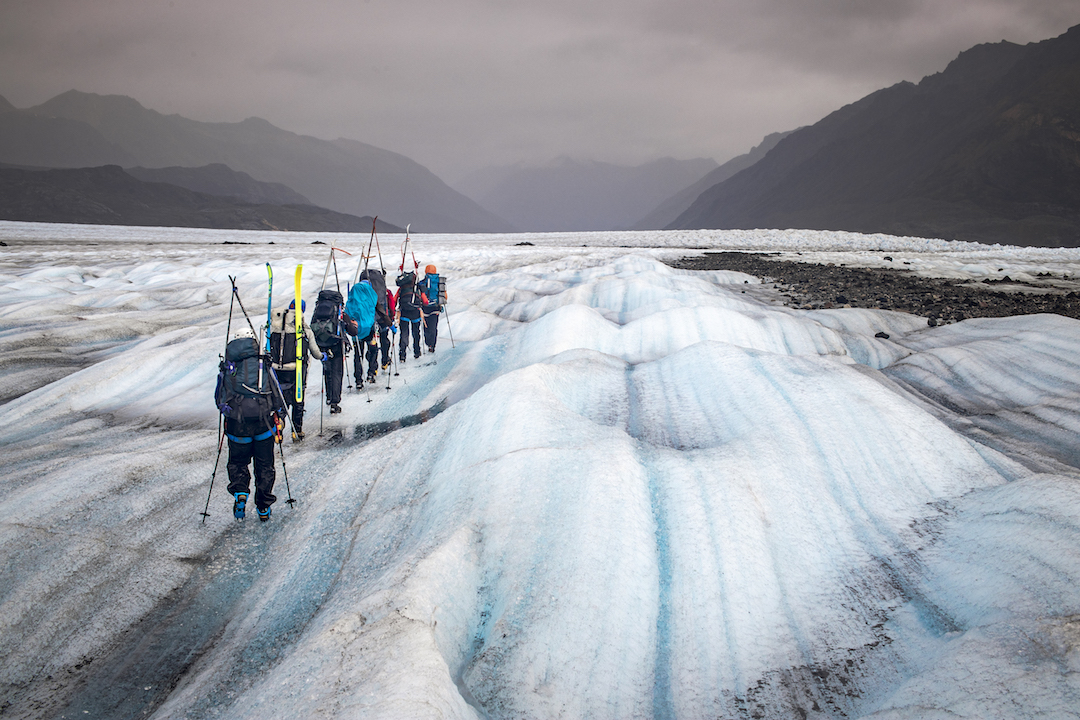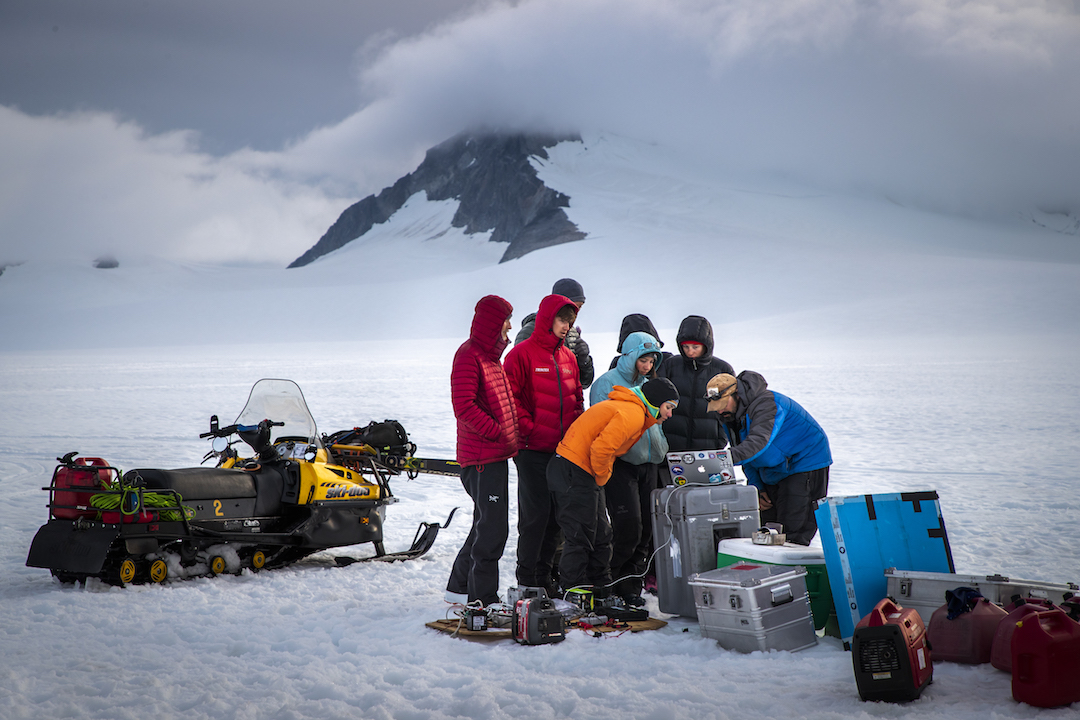Ice Pilgrimage
More than 70 Years of Studying the Juneau Icefield

WHEN CONSIDERING the world’s great pilgrimages, perhaps you think of Mecca’s Hajj, Japan’s Kumano Kodō, or Spain’s Camino de Santiago. I think of a pilgrimage across ice, of dozens of scientists, staff, and students skiing and slogging 80 miles over plains of sun-warped snow and between the dark peaks of Alaska’s Coast Mountains. It’s a kind of annual homage to a mysterious ice world we’re trying to understand, even as it’s shifting beneath us.
The Juneau Icefield Research Program (JIRP), founded in 1946, is one of the oldest glacial monitoring programs in the world, second only to the Swedish research station Tarfala. Every summer, researchers and undergraduate and graduate students spend eight weeks studying the phenomena of these glacial systems, beginning in Juneau in June and traversing north across the icefield into Canada by August. The expedition bunks at permanent sheet-metal camps along the way, while collecting GPS, isotope, radar, mass balance, and other data—measurements that track how these maritime glaciers are functioning and fluxing.
And they are fluxing—in fact, they’re shrinking, and by a lot. By some measures, Alaska’s glaciers are losing mass faster than any other polar region, contributing significantly to sea level rise (Gardner et al. 2013). Studying glaciers allows us to reconstruct past climatic situations, but also to predict changes that will disrupt human and biological communities. In southeast Alaska, glaciers support the tourism industry, from cruises to dog sledding tours, as well its fisheries, since cold-loving, stream-spawning species like salmon rely on their meltwater and nutrient inputs.

JIRP’s long-term data reveal sobering realities of how these glaciers have morphed in mass and elevation over decades. The Lemon Creek Glacier, on the more temperate and maritime- influenced western edge of the icefield above Juneau, retreated by 1,200 meters between 1948 and 2011, or about three-fourths of a mile (M.Pelto et al. 2013). The other glacier for which there is robust historical data, the Taku, is the thickest glacier in Alaska, with a sprawling accumulationzone. JIRP’s survey program has focused primarily on the Taku system, which includes several branches, measuring and monitoring its surface velocity and elevation. For most of the 20th century, the Taku was advancing and increased in thickness and therefore mass. But in 1993, it reached its maximum thickness. It has thinned ever year since.
The length of JIRP’s records allows researchers to tell complex stories and to ask compelling questions in new arenas. In 2018, researchers established a multi-week tent camp at the Matthes- Llewellyn Glacier divide, a point of low glacial flow ideal for radar imaging and core drilling. With multiple radar systems, they imaged the stratigraphy of the ice, monitored flow, and measured snow densification. They determined the deepest ice was around 900 meters, or over half a mile, thick. With shallow radar and ice cores, they discovered previously unknown liquid aquifers in the ice, which raised a host of questions: How do these aquifers form? Do they happen every year? Are they seasonal or long term? How might they contribute to mass loss?
From its inception until 2010, JIRP was under the tutelage and leadership of Dr. Maynard Miller. A beloved though sometimes polarizing figure, Miller served in the Navy in World War II and as the chief geologist for the first U.S. expedition to Everest, and was an early scholar of human-induced climate change. He began as a field assistant to the pioneer glaciologist William O. Field, who later recounted that JIRP grew out of conversations with Miller wherein the pair contemplated what factors controlled glacial systems. Glaciologists at the time only studied the termini of glaciers. But Miller and Field speculated that the “health of a glacier is found in its upper source region, not at the terminus.” Curiosity piqued, their first reconnaissance of Juneau’s “high ice” began with aerial surveys in 1946, and the annual traverse launched in 1949.

Despite having serious scientific goals, the program was never solely an academic pursuit. Miller was a passionate educator and always had students with him on the ice, performing field- work as well as learning and playing in the landscape. This legacy continues today, as JIRP in many ways serves as a educational institution, training early-career scientists in field methodol- ogy and glaciology before they venture into other regions of the cryosphere such as Greenland and Antarctica. The expedition teaches mountaineering and glacier travel skills to all participat- ing students and scientists—how to navigate the palaces of ice and snow, to travel in the shadows of and on top of mountains.
The program’s storied mountaineering history began with Dr. Miller, who accomplished an impressive tick list. While president of the Harvard Mountaineering Club, Miller made the first American ascent of Mt. Saint Elias, in 1946, with William Latady, Dee Molenaar, and William Putnam. It was after that ascent in August that he first explored the Juneau Icefield, funded in part by the American Alpine Club (AAC). Miller’s other notable climbing feats included the first ascent of Mt. Bertha in the Fairweather Range in 1940, with Bradford Washburn and Lowell Thomas Jr., and various peaks in the Boundary Ranges, rising above the Juneau Icefield. Miller also chaired the AAC’s safety committee and helped launch the annual publication Accidents in North American Mountaineering in 1948.
The program has both attracted accomplished adventurers and made them. Geologist and climber Art Gilkey, for which the Gilkey glacier and trench are named, and Ome Daiber of “SnoSeal” fame, were both expedition leaders. In 1971, students and mountaineers Eric Reynolds and Dave Huntley started the “Marmot Club” during a JIRP season (to become a “Marmot,” one had to climb a peak with an existing member of the club). That summer, the two made prototypes of down clothing and equipment that would later be the genesis of the Marmot outdoor gear company. Mountaineer and glaciologist Alison Criscitiello, who led the first all-female ascent of Lingsarmo (Pinnacle Peak) in India, was a JIRP student in 2003. Canadian explorer and writer Kate Harris was a student in 2004, and later served on the JIRP board of directors. Groundbreaking avalanche researcher Ed LaChapelle was a JIRP field leader in the 1950s. These are the types of characters who are pulled into the Juneau Icefield’s gravitational field time and time again.
Studying and exploring this landscape feel inextricably linked, connected by a love of the place, even as we sit in a place of knowing its doomed fate. As Aldo Leopold wrote, “One of the penal- ties of an ecological education is that one lives alone in a world of wounds.” The 2018 season was characterized by gloriously sunny weather and low snow. But every year feels like it’s a low snow year, at least anecdotally. Blue ice appears earlier, our snow pits are shallower, and the snowline creeps up faster. Such changes complicate the traverse, our migration that has followed the same timeline for decades. Last summer, we abandoned our second base camp two weeks earlier than usual because spreading blue ice threatened to trap us in the center of the icefield.
These abrupt shifts dictate the nature of our fieldwork and travel. Journeys off the nunatak— that is, any time we leave rock outcrops to travel on snow and ice—are increasingly precarious. Expedition members now where helmets and harnesses at all times while on glacier. We are frequently roped up in areas we’ve previously not been. The sketchy conditions remind us all of the dismaying truth that the Juneau Icefield is anticipated to be entirely gone by 2200 (Zeiman et al. 2016). The wasting process will continue for centuries, and these snowfields will transform into fjords of epic proportions. Until then, the pilgrimage continues.
About the Author: Drew Higgins is a freelance science writer and environmental educator based in midcoast Maine. The 2018 field season was her second on the ice with JIRP.






